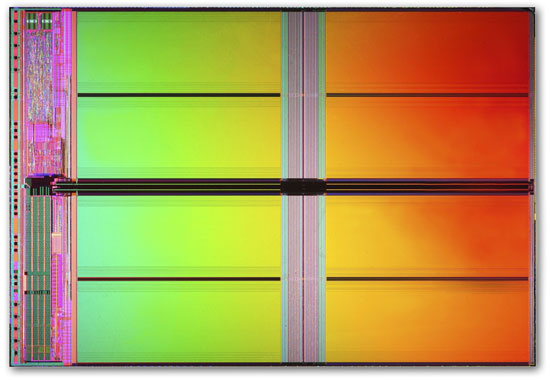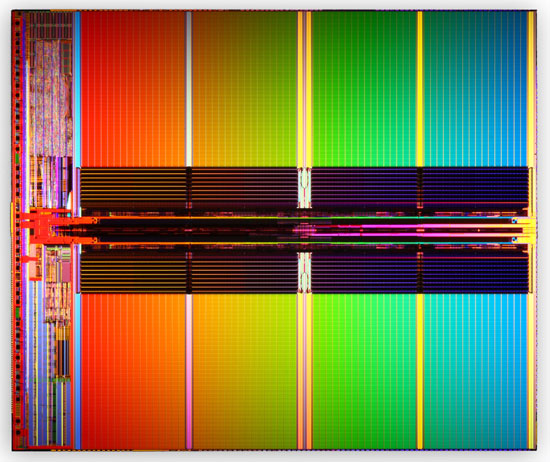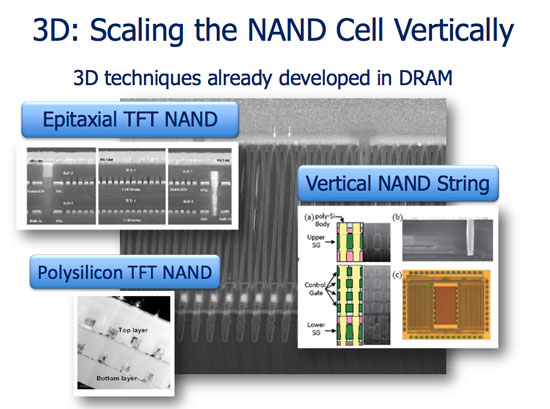Intel & Micron Announce 25nm NAND Flash Production, SSDs to get Bigger/Cheaper in Q4
by Anand Lal Shimpi on January 30, 2010 12:00 AM EST- Posted in
- Storage
I wasn’t supposed to be able to tell you about this until Monday, but it looks like the news leaked early so IMFT gave us the green light.
Intel and Micron jointly formed IMFT (Intel-Micron Flash Technologies), LLC back in 2006. The two companies share production from the venture. Intel gets 49% of IMFT’s flash production and Micron gets 51%.

In the usual Intel tradition, IMFT aggressively scales process technology to be competitive. The company started manufacturing at 72nm, spent 2008 at 50nm and just last year scaled down to 34nm. The latter is what found its way into Intel’s X25-M G2 as well as Micron’s soon-to-be released RealSSD C300.

Today IMFT is announcing that it has begun sampling 2-bits-per-cell MLC NAND flash manufactured using 25nm transistors. The company believed it had a 6 month head start over the competition in 34nm, and now believes that with 25nm NAND it’s roughly a year ahead of anyone else.
Volume production will happen sometime in Q2, with products shipping before the end of the year. In my last SSD article I mentioned that Intel’s 3rd generation X25-M would be shipping in Q4 at 160GB, 320GB and 600GB. These drives will use IMFT’s new 25nm flash.
The first 25nm product is an 8GB (64Gbit) 2-bits-per-cell MLC NAND flash. A single 8GB die built on IMFT’s 25nm process has a die size of 167mm2. Immersion lithography is apparently necessary to produce these 25nm NAND devices, but the extent is unclear. This is technically Intel’s first device that requires immersion lithography to manufacture.

25nm IMFT 2-bit MLC NAND Flash, 8GB, 167mm2
The 34nm flagship was a 4GB (32Gbit) 2-bits-per-cell MLC NAND device with a die size of 172mm2. At 25nm you basically get twice the capacity at the same die size, which should translate into twice the SSD capacity at the same price as a 34nm drive today.

34nm IMFT2-bit MLC NAND Flash, 4GB, 172mm2
Obviously supply and demand economics play their roles here. We may not see the sort of aggressive pricing we want to on 25nm X25-M drives if demand remains as high as it has been for the 34nm G2s.
Last year IMFT announced plans to deliver a 3-bit-per-cell 34nm MLC NAND flash. Today's announcement pretty much negates the need to bring those devices to market. Although at some point we'll probably see 3-bit-per-cell at 25nm. At this point 3-bit-per-cell MLC flash is only suitable for cheaper or low cycle devices like USB sticks. In a SSD the performance and reliability tradeoffs just aren't worth it.

34nm IMFT 3-bit MLC NAND Flash, 4GB, 126mm2
The 25nm IMFT NAND devices support ONFi 2.2, meaning the interface speed can reach a maximum of 200MB/s.
The other major change to the 25nm NAND is an increase in the page size. At 50nm and 34nm, IMFT’s page size was 4KB. At 25nm on the 8GB device the page size is now 8KB. Block size has also gone up from 128 pages to 256 pages. This will obviously have performance implications and require some firmware reorganization, but given that Intel has known this was coming for some time now I would expect that its 3rd generation drives will be optimized for 25nm.
IMFT believes there’s still hope for scaling flash devices even further. It's ridiculous to think about how small these transistors are getting. As we approach single-digit-nm dimensions we can start counting atoms when we look at these transistors:

Right now IMFT is on a 12 - 15 month cycle, so we can expect the next process shrink to begin sampling in mid-2011, shipping in 2012.


If IMFT can ramp up production of 25nm NAND flash, 2012 may be the year of the first truly affordable mainstream SSDs.










39 Comments
View All Comments
CurseTheSky - Saturday, January 30, 2010 - link
For $300, I would grab the 160GB G2 in a heartbeat. I paid $450 for mine and it's worth every penny.Yes, newer technology is going to come out that will make these feel slow, small, and generally outdated. For the most part, I don't play the waiting game unless something is right around the corner (for example, I wouldn't advise anyone to make a major graphics card purchase right now until we see what happens in March).
Griswold - Sunday, January 31, 2010 - link
I dont think you'll see SSDs anytime soon (read: years) that make current (intel) SSDs feel slow unless you like to play benchmarks all day long or are exclusiveley interested in sequential read/write performance.wumpus - Sunday, January 31, 2010 - link
You will almost certainly find an SSD that will make current SSDs feel *small*. New SSDs could easily feel faster than non-TRIM current SSDs. You might need a later motherboard with some yet-to-be-speced SATA3 system to make a state-of-the-art (1/31/2010) seem slow, and then only being used for virtual memory swap.mcnabney - Sunday, January 31, 2010 - link
Why wait?You should buy products when you need them. Current guesses on Fermi is that it should be a bit faster than a 5870, but it is going to cost a ton. There will also not be anything until mid-summer to fill the needs of consumers that like to game, but don't have a trust fund. And soon after Fermi the new generation of AMD/ATI will be rolling out (5XXX was a die shrink and DX11 only, not a new design). Just buy when you need it and stop trying to time the market.
dagamer34 - Saturday, January 30, 2010 - link
As exciting as this is, we need more manufacturers to develop similar technology so that prices can get cheaper!vol7ron - Saturday, January 30, 2010 - link
Anand,Could you discuss a little more about the ONFi? Also, you said the interface speeds can reach 200MB/s, how does this compare to the previous speeds?
Thank you,
vol7ron
murphyslabrat - Saturday, January 30, 2010 - link
Yessir, I know you think this every time a new flash technique is developed, but I can't wait for Christmas.jcollett - Wednesday, May 5, 2010 - link
Anand was right about the smaller drives in that article back in 2009. The supposed price drops for the OCZ Colossus line did not materialize with current low street prices being about 50% higher than MSRP shown in the article. Too bad ....iwod - Thursday, February 17, 2011 - link
Most of the benchmarks are not even reaching the practical / theoretical limits of SATA 3Gbps speed. So why would a fatter pipe , SATA 6Gbps allow much higher speed with the same controller?And have you figured out why Kingston V+ is so fast on benchmarks yet? I was asking last time and no one provide an solid answer. Like you have mentioned, the 4 corners of SSD performance, Seq R/W, Random R/W. Kingston perform very well in Seq R/W and only the low end for Random R/W. However it was the fastest in multiple Anand / Synthetic benchmarks.
P.S - VR-Zone just posted Next Gen Intel SATA 6Gps SSD will be out on 1st of March. Will we get a preview before that?